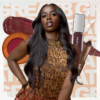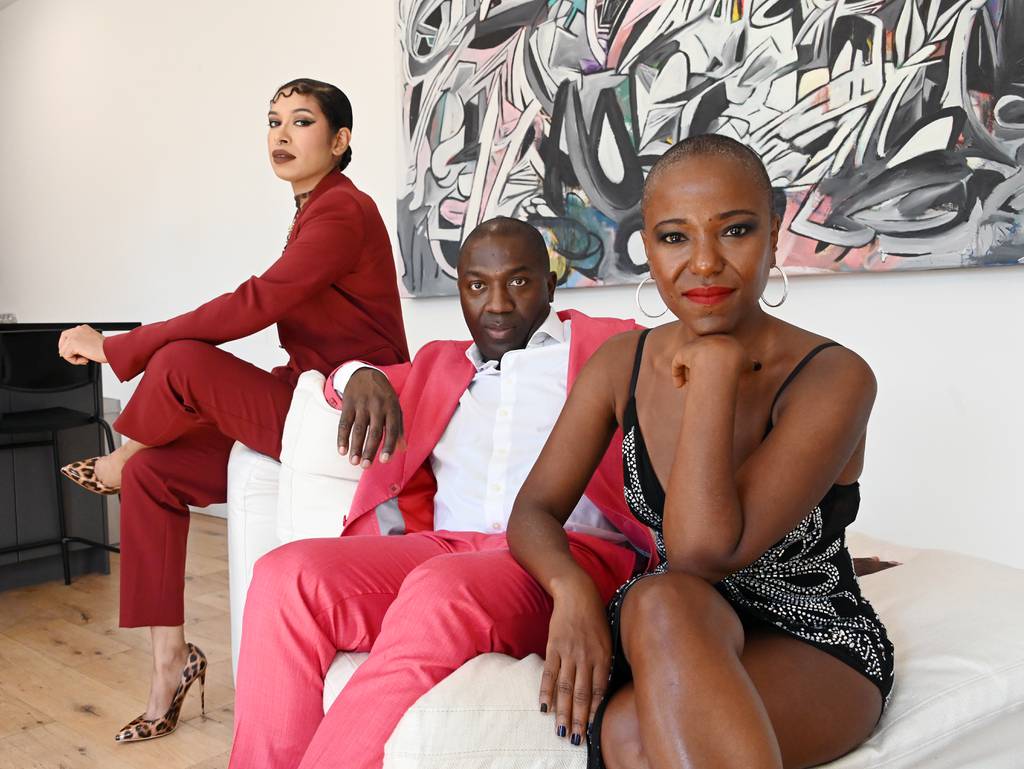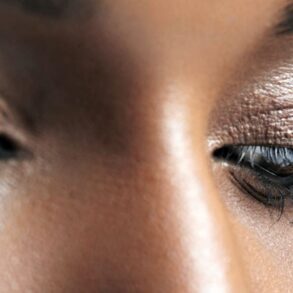On her 25th birthday, Candice Christmas got two tattoos: on her left wrist, the words “Don’t Dream It,” which matches the “Be It” on her right wrist.
They’re a tribute to the song of the same name performed by Tim Curry in both the original stage production and the 1975 film version of “The Rocky Horror Picture Show,” the cult classic that has inspired shadow cast performances across the country.
For Christmas, 39, the tattoo — and “Rocky Horror” — is a reminder to stop taking life so seriously.
“I feel like the whole thing with play, especially with Black folks … we’re always under a microscope. We have to be perfect,” Christmas said. “This allows you to play, to let that guard down, to have fun.”
Christmas gets to play on stage, which for her and other Black performers in the Baltimore area can be a safe place to find community and express themselves through unconventional, boundary-pushing art.
Christmas, whose stage name is Bunny Vicious, has been in a “Rocky Horror” production every year since 2009. She’s a part of Chocolate Covered Rocky Horror, a majority-Black and Baltimore-based Rocky shadow cast.
The show is also home for people like Shannon Cummings, who is playing a Transylvanian and is the makeup artist for this Halloween’s slate of “Rocky Horror” performances. Cummings, who uses they/them pronouns, knew little about the show before joining the cast. But they said finding a Black, queer community was a “dream.”
“I finally felt like this is somewhere I fit in,” Cummings, who performs as Mx Kittie, said. “I fit in with my color and I fit in with my creed and just who I am seems to resonate more with these people and with this cast.”
Earl Melvin, the founder of Chocolate Covered Rocky Horror, also took inspiration from the “Don’t dream it, be it” film mantra when creating a “Rocky Horror” experience “that is African American centered.”
“I was influenced by this idea of putting Blackness on the forefront and saying, ‘Hey, we’re here. We’re capable of this,’” Melvin said.
In 2022, Chocolate Covered Rocky Horror started performing a 1960s-themed version of the show, with dance moves, costumes and makeup inspired by the era. Janet Weiss and Brad Majors, the core couple of the show who stumble upon the mansion where Dr. Frank-N-Furter is building a man, are played by white actors — and so, occasionally, is Dr. Everett Von Scott, Melvin said. The rest of the cast is Black. And the show maintains its deep ties to the LGBTQ+ community; Janet is played by Betty O’Hellno, a burlesque drag performer.
“[In] the ‘Rocky Horror’ 60s show, I was able to maintain our identity as an African American shadow cast experience, but also be inclusive,” Melvin said. “Being inclusive has opened up many doors for my production company. It has grown the show significantly.”
Melvin first discovered “Rocky Horror” while attending University of Maryland, College Park. As he scanned the line of audience members and their “edgy and beautiful” colorful, sparkly outfits, he noticed that there weren’t many people of color in line.
But now, he’s noticing more Black audience and cast members at Chocolate Covered shows, which included six shows this season; the last performance is Oct. 28 at Baltimore Center Stage. The shadow cast generally performs during Halloween, Black History Month and Pride Month each year.
“I just knew that Chocolate Covered Rocky Horror would be something that people needed,” Melvin said.
Eric Cotten is the president of the Baltimore Filmmakers Collective and an independent writer, producer and director of short films who has worked in queer arts spaces. A fan of “Rocky Horror,” Cotten said having a majority-Black cast makes “perfect sense.”
“The concept of ‘Rocky Horror’ is that these are people who are not of the norm but they have created their own community in which they’re very happy and thrive in,” Cotten said. “I think in a lot of ways, that applies to all minority cultures. So as a Black person, I could clearly relate to that and I relate to the happiness of them as a group existing among themselves.”
Cotten said full audience participation is the hallmark of a good Rocky performance. And it’s something one can find at another majority-Black show: “The Sweet Spot Burlesque.”
The show started as an annual erotica show incorporating poetry, modern dance, live painting and a band in New York in 2006, originally billed as “Freak Nasty.” It then rebranded as burlesque in 2011, along with its name change, and is now headed by married couple Ainsley Burrows and Laurielle Noël. Burrows is the founder, in addition to hosting and performing poetry at the shows; Noël is the CEO and does spoken word performances of erotic fiction.
The show, themed around popular erotica and the art of strip tease, incorporates burlesque dance, comedy and shibari, Japanese rope bondage, among other elements.
“Sweet Spot” kicked off its six-city tour in Baltimore Oct. 8 and will end in New York City Dec. 3.
Burrows and Noël said their Black, Caribbean and New York roots — though the couple moved to Baltimore last year — directly influence the show through music choices, the use of call and response and a 10-minute intermission dance party.
“We try to center Black people, the Black body, because there’s not a lot of spaces where you can go to a burlesque show and see a whole Black cast,” Burrows said, though he noted they always take on “the best of the best,” which sometimes includes non-Black performers.
Dustin Wax, executive director of the Burlesque Hall of Fame in Las Vegas, said burlesque is still whiter than the rest of the country while the “leading lights” of the community are disproportionately nonwhite.
Denasha Bullock, 35, is a burlesque dancer under the stage name Eva Mystique. She said while performing in burlesque, she is always telling a story and is in control of what sexy is.
But that doesn’t come without push back.
Weekend Watch
Weekly
Plan your weekend with our picks for the best events, restaurant and movie reviews, TV shows and more. Delivered every Thursday.
“You would think that there would be more freedom to express sexuality in burlesque. But Black bodies, when we dance in certain ways, it’s not received well. It’s not even seen as real burlesque,” Bullock, who is Afro-Indigenous, said. “A Black body in white spaces is seen as raunchy, is seen as not classy.”
Wax said that historically, non-white burlesque performers were often othered and treated as exotic. And today, he doesn’t know a Black burlesque performer who hasn’t been asked to do Josephine Baker’s Danse Sauvage, featuring her famous banana skirt.
Bullock said “Sweet Spot” is a place where she can move her body in a way that feels good without being worried about being perceived as “less than.”
Wax said burlesque is a form of resistance through sexuality, a theme that endures both in “Sweet Spot” and “Rocky Horror” performances. And its numbers are growing.
“The last seven years have not been easy for women, or anyone non-white or anyone not straight,” Wax said. “And burlesque has exploded, I mean, it’s gotten just stronger. Because there’s a lot to resist. And there’s a lot of people that are looking for ways to push back and to assert their own individuality.”
Cummings, who has a “Be Brave” tattoo on their back, said the “Rocky Horror” stage is a source of freedom in a world where violence and vitriol are increasingly targeted at the queer community.
“It’s become a safe space of art and expression, where we can be free to be us and we don’t have to dream it: we can actually be it,” Cummings, 35, said.
This post was originally published on this site be sure to check out more of their content.









